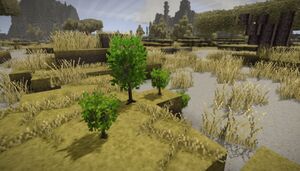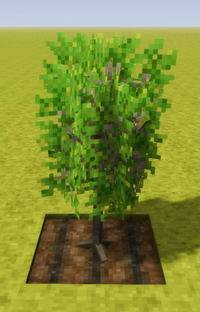Manioc
| Soaked cassava | |
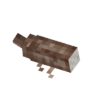
| |
| Empilable | 64 |
| Périssable | |
| Temps de fraîcheur | 0 hours |
| Temps de transition | 24 hours |
| Ratio de transition | 1[1] |
| Objets | |
| Manioc séché | |
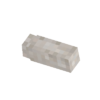
| |
| Empilable | 64 |
| Périssable | |
| Temps de fraîcheur | 112 an |
| Temps de transition | 5 jours |
| Ratio de transition | 0.5[2] |
| Objets | |
| Manioc brut | |
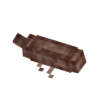
| |
| Empilable | 64[3] |
| Périssable | |
| Temps de fraîcheur | 28 jours |
| Temps de transition | 5 jours |
| Ratio de transition | 0.5[4] |
| Objets | |
| Manioc | |
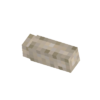
| |
| Empilable | 64[5] |
| Nourriture | |
| Satiété | 100 peeled, 120 in meals[6] |
| Catégorie |
Légumes |
| Périssable | |
| Temps de fraîcheur | 10 heures |
| Temps de transition | 2 jours |
| Ratio de transition | 1[7] |
| Objets | |
Le manioc est une source de nourriture. Le manioc pelé fournit une nutrition en légumes, tandis que le manioc séché fournit une nutrition en céréales. Il n'est pas possible de le consommer à l'état brut.
Obtention
Le manioc peut pousser spontanément comme culture sauvage, généralement sous les climats chauds ou très chauds. Il n'est vendu par aucun marchand, et ne peut pas faire l'objet d'un butin dans les jarres craquelées des ruines.
Players starting in a default Temperate area will need to travel tens of thousands of blocks south to reach regions where cassava is likely to generate.
Cassava and cassava seeds cannot be found in cracked vessels[8] or purchased from any traders.[9]
Culture
Le manioc pousse entre 4 et 44°C, sa croissance demande 6,67 mois (60 jours) avec un paramétrage par défaut de 9 jours par mois. Il passe par 9 étapes de croissance. Le manioc consomme 25% des ressources en N (azote) de son bloc de terre agricole. Une fois mûr, il peut être récolté à la main, au couteau ou à la faux. À pleine maturité, chaque plant d'une culture produit un manioc brut et au moins une semence lors de la récolte. Récolter des plants avant maturité ne produit aucun légume et peut même ne donner aucune semence.
Cassava crops consume 25 K (potassium)[10] from the soil over 9 stages[11] of growth. Cassava crops take 5 months[12] to mature, (45 days at default settings, assuming a growth rate near 100%. Low moisture or nutrient levels can significantly delay maturation.
Cassava can be harvested by breaking the crop, no tool necessary. Each block of mature cassava crops will yield 14-18 cassavas[13] and 1-2 seed packets. Harvesting at stage 8 will yield 5 cassavas ± 0.8 and 1 seed packet.[14] Harvesting before stage 8 has a 0% chance of getting any cassavas, and a 70% chance of getting 1 seed packet.[15]
Utilisation
Contrairement à la plupart des cultures, le manioc n'est consommable ni cru ni cuit, tant qu'il n'a pas été pelé. Ce processus se fait en plaçant le manioc brut dans un baril rempli d'eau (il faut 1L d'eau par manioc) et scellé pour une journée. Une fois ceci terminé, les maniocs trempés peuvent être pelés à l'aide de n'importe quel couteau. À ce stade, ils peuvent être consommés crus ou servir d'ingrédient pour la cuisine. Le manioc pelé est classé dans la catégorie légumes, et peut servir d'ingrédient pour :
- Ragoût de viande (1-2)
- Ragoût de légumes (1-2)
- Soupe (1-3)
- Bouillie (1-2)
Soaking
Each raw cassava needs 1L of water to soak in. A barrel holds a maximum of 50L of water, and 50 raw cassava. Fill a barrel using a bucket (holds 10L), a jug (holds 3L) or a bowl (holds 1L). When the quantity of water meets or exceeds the quantity of raw cassava, the barrel interface will describe the output and the Seal button will close the lid of the barrel.
The Block info HUD will display the barrel's contents and progress when the player mouses over the barrel. After 24 hours in-game have passed,[16] the barrel lid will open and the soaked cassava will begin drying. If the quantity of water in the barrel exceeded the quantity of raw cassava when the barrel was sealed, the excess water will still be in the barrel.
To peel soaked cassava, place it in the crafting grid below any knife.
Séchage
After 48 hours in-game have passed, soaked cassava becomes dried cassava, whether or not it was peeled. The Block info HUD will display the drying progress when the player mouses over the cassava.
Drying soaked cassava is best done in a container and location that maximize its freshness, so the drying process completes before spoiling begins. If you intend to dry cassava for use as a grain, don't peel it.
Le manioc pelé devient un manioc séché après 48 heures de stockage à l'air libre. Ce manioc ainsi séché bénéficie d'une très longue durée de fraicheur de 112 jours, mais en l'état, il ne peut être ni consommé ni nuit. Il doit auparavant être transformé en farine à l'aide d'une meule. La farine de manioc est traitée comme les autres farines de céréales, et peut servir à la fabrication de pain ou de bière de manioc.
Cooking
Peeled cassava is categorized as a vegetable, and can be used as an ingredient in:
- Meat stew (1-2 slots after red meat)
- Vegetable stew (1-4 slots)
- Soup (1-3 slots with water)
- Porridge (1-2 slots after grain)
Dried cassava cannot be eaten even if peeled; it must be ground. Cassava flour is categorized as a grain, and can be used as an ingredient in:
Stockage
Après récolte, le manioc peut être conservé dans l'inventaire ou dans certains conteneurs fixes. Il tire également parti d'un stockage en cellier. La durée de conservation du manioc peut également être améliorée avec un stockage plus adéquat. Conserver le manioc pelé dans un conteneur comme la jarre retardera sa transformation en manioc séché.
Remarques
Galerie
Voir aussi
Références
- ↑ Lines 32-37 of %appdata%\Roaming\Vintagestory\assets\survival\itemtypes\food\rawcassava.json
- ↑ Lines 39-44 of %appdata%\Roaming\Vintagestory\assets\survival\itemtypes\food\rawcassava.json
- ↑ Line 3 of %appdata%\Roaming\Vintagestory\assets\survival\itemtypes\food\rawcassava.json
- ↑ Lines 25-30 of %appdata%\Roaming\Vintagestory\assets\survival\itemtypes\food\rawcassava.json
- ↑ Line 3 of %appdata%\Roaming\Vintagestory\assets\survival\itemtypes\food\vegetable.json
- ↑ Lines 17-19 and line 65 of %appdata%\Roaming\Vintagestory\assets\survival\itemtypes\food\vegetable.json
- ↑ Lines 96-102 of %appdata%\Roaming\Vintagestory\assets\survival\itemtypes\food\vegetable.json
- ↑ Lines 19-81 %appdata%\Roaming\Vintagestory\assets\survival\blocktypes\clay\lootvessel.json
- ↑ Lines 48-386 of %appdata%\Roaming\Vintagestory\assets\survival\entities\humanoid\trader-agriculture.json
- ↑ Lines 62-63 of %appdata%\Roaming\Vintagestory\assets\survival\blocktypes\plant\crop\cassava.json
- ↑ Line 64 of %appdata%\Roaming\Vintagestory\assets\survival\blocktypes\plant\crop\cassava.json
- ↑ Line 65 of %appdata%\Roaming\Vintagestory\assets\survival\blocktypes\plant\crop\cassava.json
- ↑ Lines 52-55 of %appdata%\Roaming\Vintagestory\assets\survival\blocktypes\plant\crop\cassava.json
- ↑ Lines 48-51 of %appdata%\Roaming\Vintagestory\assets\survival\blocktypes\plant\crop\cassava.json
- ↑ Lines 56-58 of %appdata%\Roaming\Vintagestory\assets\survival\blocktypes\plant\crop\cassava.json
- ↑ find source
| Agriculture | |
|---|---|
| Aliments sauvages | Baies • Fruit de saguaro • Champignons • Roseaux (et papyrus) |
| Céréales | Amarante • Manioc • Lin • Riz • Seigle • Épeautre • Tournesol |
| Légumes | Chou • Carotte • Oignon • Navet • Panais • Arachide • Citrouille • Soja |
| Fruits | Arbres fruitiers • Ananas |
| Autre | Engrais • Apiculture • Serre |
| Outils | Houe • Faux • Pressoir |
| Voir aussi | Élevage • Cuisine • Préservation des aliments |
| Wiki Navigation | |
|---|---|
| Vintage Story | Guides • Foire aux questions (FAQ) • Vintage Story Original Soundtrack • Versions • Controls |
| Systèmes de jeu | Artisanat • Taille de pierre • Modelage d'argile • Forge • Cuisine • Température • Faim • Minage • Stabilité temporelle • Puissance mécanique • Commerce • Agriculture • Élevage |
| Le Monde | Création du monde • Biomes • Météo • Tempêtes temporelles |
| Objets | Outils • Armes • Armure • Vêtements • Sacs • Matériau • Nourriture |
| Blocs | Terrain • Plantes • Décoratifs • Éclairage • Fonctionnels • Minerai |
| Créatures | Entités hostiles • Animaux • PNJs • Joueurs |
| Miscellaneous | Liste des commandes client • Liste des commandes serveur • Creative Starter Guide • Bot System • How_to_use_WorldEdit • Caméra cinématique • Enregistrement de vidéos à taux variable • ServerBlockTicking |
